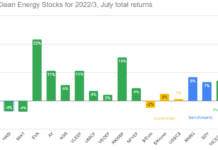Most alternative energy investors are aware of North American wind power’s very bright growth prospects. In past articles, we discussed encouraging projections for the US and Canadian (PDF document) wind markets between now and 2015. While onshore European capacity is fast being exhausted, North America is only beginning its foray into wind and some major capex can be expected in this space over the coming years. Besides solid expected growth, another phenomenon is currently impacting the wind industry; consolidation. This is a global movement that is affecting all of the power gen sector, and that has no-doubt been aided by easy credit in the past few years. Examples of recent deals in the North American wind industry include EDP’s July, 2007 acquisition of Horizon Wind for $2.7 billion, and Suez’ July, 2007 acquisition of Ventus Energy (PDF document) for C$124 million. Playing Growth & Consolidation Two of the most interesting ways to play growth and consolidation in the North American wind sector lay on the Canadian side of the border. They are two Independent Power Producers (IPPs) with attractive pipelines of projects, good forward-looking revenue visibility because of their exposures to Power Purchase Agreements (PPAs) with credit-worthy customers, and attractive take-over targets due to their size and the location of their generation assets. These two companies are: Boralex [TSX:BLX or BRLXF.PK] and Canadian Hydro Developers [TSX:KHD or CHDVF.PK]. Boralex Boralex currently runs a generation portfolio totaling around 350 MW, with 103 MW of wind. Over the next five years, however, Boralex is expected to add another 690 MW of wind to its portfolio. Besides having access to PPAs, Boralex is also active in the US Renewable Energy Credits (RECs) market – in 2005 and 2006, respectively, one of the company’s facilities in the US recorded C$8.1 million and C$6.2 million in RECs revenue alone. With 2007E EV/EBITDA of around 12x and 2007E PE of around 21x, Boralex is trading roughly in line with its comps. The company is geographically well-diversified, with operations in Quebec (one of Canada’s hottest wind markets), Ontario, the Northeastern US and France.  Canadian Hydro Developers At upwards of 60x 2007E PE and around 24x 2007E EV/EBITDA, KHD does not come cheap, either as a stand-alone stock or relative to industry peers. However, the company has a very attractive pipeline of wind projects across Canada, and valuations are expected to converge with industry averages over the next three years. Canadian Hydro currently has around 265 MW of generating assets with around 154 MW of wind. The company has a further 384 MW of wind currently under construction and a total project pipeline of about 1,400 MW – one of the most interesting such pipelines of any mid-size North American IPP. While KHD is an expensive buy at the moment, a lot of that has to do with all of the growth the firm is projected to undergo between now and 2010, as well as with a high amount of revenue visibility associated with high exposure to PPAs.
Canadian Hydro Developers At upwards of 60x 2007E PE and around 24x 2007E EV/EBITDA, KHD does not come cheap, either as a stand-alone stock or relative to industry peers. However, the company has a very attractive pipeline of wind projects across Canada, and valuations are expected to converge with industry averages over the next three years. Canadian Hydro currently has around 265 MW of generating assets with around 154 MW of wind. The company has a further 384 MW of wind currently under construction and a total project pipeline of about 1,400 MW – one of the most interesting such pipelines of any mid-size North American IPP. While KHD is an expensive buy at the moment, a lot of that has to do with all of the growth the firm is projected to undergo between now and 2010, as well as with a high amount of revenue visibility associated with high exposure to PPAs.  Two Of a Kind… Both firms belong to a very rare breed – publicly-listed alternative energy generation pure-plays. While there are a number of similar companies listed on the Toronto Stock Exchange, most of them are income trusts with limited growth pipelines or small players with next to no track records. Both companies are increasingly on the radar of public market investors due their projected growth and to the fact that they are potential acquisition targets. Fundamentally-speaking, both look very attractive in the medium term (3 to 5 years) due to their extensive exposure to various schemes by Canadian provincial governments to boost wind generation capacity. These two companies really are, for all intents and purposes, two of a kind. DISCLOSURE: The author is long Canadian Hydro Developers.
Two Of a Kind… Both firms belong to a very rare breed – publicly-listed alternative energy generation pure-plays. While there are a number of similar companies listed on the Toronto Stock Exchange, most of them are income trusts with limited growth pipelines or small players with next to no track records. Both companies are increasingly on the radar of public market investors due their projected growth and to the fact that they are potential acquisition targets. Fundamentally-speaking, both look very attractive in the medium term (3 to 5 years) due to their extensive exposure to various schemes by Canadian provincial governments to boost wind generation capacity. These two companies really are, for all intents and purposes, two of a kind. DISCLOSURE: The author is long Canadian Hydro Developers.
DISCLAIMER: The information and trades provided here are for informational purposes only and are not a solicitation to buy or sell any of these securities. Investing involves substantial risk and you should evaluate your own risk levels before you make any investment. Past results are not an indication of future performance. Please take the time to read the full disclaimer here.







